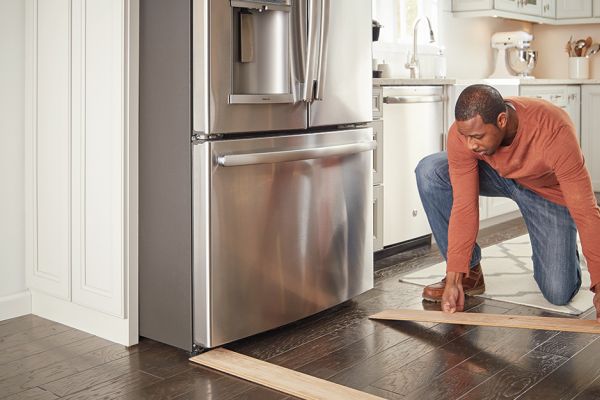Before you try to move your refrigerator around, make sure you know how much weight you’re dealing with. Cause it always feel like a challenge, right? This article will provide you the answer for that question and also give you tips and things to consider before and during moving a refrigerator.
What does my refrigerator weigh?
It depends on a variety of factors but typically, an average refrigerator weighs anywhere between 180-360 pounds or 80-160 kgs.
Some of the factors that determine refrigerator weight include the model and the type of fridge. To calculate a refrigerator’s weight, to get a general idea, it is a bit more than 10 pounds per cubic foot.
For example, a Whirlpool refrigerator with a 25-cubic-foot French door unit, weighs over 330 pounds whereas a Whirlpool top freezer with a size of 18 cubic feet weighs over 170 pounds. Smaller units of refrigerators can weigh around 75 pounds while the larger ones can be over 400 pounds.

The weight of your Refrigerator can also depend on its age
Size and models can affect refrigerator weight but we’re pretty sure you know that already. But, did you know that refrigerators’ age can also matter? No, it doesn’t mean that they can get heavier as they get older. It means if you have a refrigerator made in the 1980s or earlier, it is likely to weigh more than a modern unit of a similar type.
People have made significant improvements in technology over the years and the materials that are used in today’s refrigerators are much lighter than the past.
However, there can also be refrigerators that are more modern but weigh more than some older ones. This can be because of modern accessories that weren’t invented or thought of at the time. This includes modern features such as temperature-controlled drawers, special shelving designs, and smart refrigerator features.
You may also like to read: Here are 13 Bad Cleaning Habits You Need to Get Rid of ASAP!
Preparing for moving your refrigerator
Here are some steps you should follow in order to prepare for moving your refrigerator around.
- Step 1: Remove everything from the fridge prior to moving: Before you start moving those big things around, you should empty its contents and any food that’s in it. Try emptying foods slowly until the day finally comes as it will remain unplugged while you’re moving it and if you’re moving houses, it will be in the back of the truck for some time, you don’t want any food lingering in it.
- Step 2: Unplug the refrigerator and clean the inside of it properly: After emptying all the contents of the fridge, unplug it and clean the inside of the fridge properly to prepare it for the move. There are removable shelves and trays in any fridge. Start by removing them and packing them separately which can also remove some weight, prevent them from jostling around, and make it easier for you to move.
- Step 3: Remove the door of the refrigerator: It will make it much lighter and easier to grab when moving around if you just remove the door.
How to move a refrigerator?
A refrigerator should be kept upright while moving for avoiding damage to loose items and the seal system. However, all fridges aren’t the same and you should consider different instructions for different types and weights. If you have no other option but to lay a unit down while moving, make sure that the top freezer models lay on the side without hinges which allows the door to stay closed.
For the side by side units, lay it on the freezer side. For French door units, the fridge must always stay upright, with just a bit of tipping considered when necessary for it to maneuver into place.
If you’re using a dolly to move your refrigerator, place one of the sides against the dolly to prevent damage and not its front or back.
Another thing you should remember is, if it was placed on its side during the whole moving process, do not plug it in until it has been standing upright for some time.

Problems that can arise while moving a refrigerator
The main issue when moving a refrigerator is that water can leak from the lines and there can be problems with the refrigerator because of leaking liquids in the motor that can move around.
To avoid this, make sure that the fridge is cleaned thoroughly and prepared well before the movement, and care measures should be taken during the moving process making sure that it works properly in its new location.
Laying down a refrigerator
Sometimes laying down a refrigerator simply can’t be avoided when moving and it needs to be placed on its front, back, or side rather than upward. To do this properly, make sure you wrap the fridge securely and it is picked up from the side rather than the front to reduce damage.
Side-by-side fridges should be put down on the freezer side making the doors less likely to open. For top freezer models, put the unit on the opposite side of where the hinges are located.
Compact refrigerators should always remain in an upright position because of the design of the drain and if placed on its side, water will run back into the appliance. If there’s no other way, allow it to drain and turn it off a few days in advance.
FAQs:
1. How much does a refrigerator generally weigh?
It depends on a variety of factors but typically, an average refrigerator weighs anywhere between 180-360 pounds or 80-160 kgs.
2. Why do refrigerators have different weights?
Some of the factors that determine refrigerator weight include the model and the type of fridge. To calculate a refrigerator’s weight, to get a general idea, it is a bit more than 10 pounds per cubic foot.
3. Why are modern refrigerators lighter than older ones?
People have made significant improvements in technology over the years and the materials that are used in today’s refrigerators are much lighter than the past making it weigh less.
You may also be interested in another similar article: What is a Daybed? Should You Have One in Your House?
